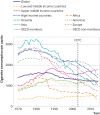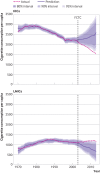Impact of the WHO Framework Convention on Tobacco Control on global cigarette consumption: quasi-experimental evaluations using interrupted time series analysis and in-sample forecast event modelling
- PMID: 31217191
- PMCID: PMC6582266
- DOI: 10.1136/bmj.l2287
Impact of the WHO Framework Convention on Tobacco Control on global cigarette consumption: quasi-experimental evaluations using interrupted time series analysis and in-sample forecast event modelling
Abstract
Objective: To evaluate the impact of the WHO Framework Convention on Tobacco Control (FCTC) on global cigarette consumption.
Design: Two quasi-experimental impact evaluations, using interrupted time series analysis (ITS) and in-sample forecast event modelling.
Setting and population: 71 countries for which verified national estimates of cigarette consumption from 1970 to 2015 were available, representing over 95% of the world's cigarette consumption and 85% of the world's population.
Main outcome measures: The FCTC is an international treaty adopted in 2003 that aims to reduce harmful tobacco consumption and is legally binding on the 181 countries that have ratified it. Main outcomes were annual national estimates of cigarette consumption per adult from 71 countries since 1970, allowing global, regional, and country comparisons of consumption levels and trends before and after 2003, with counterfactual control groups modelled using pre-intervention linear time trends (for ITS) and in-sample forecasts (for event modelling).
Results: No significant change was found in the rate at which global cigarette consumption had been decreasing after the FCTC's adoption in 2003, using either ITS or event modelling. Results were robust after realigning data to the year FCTC negotiations commenced (1999), or to the year when the FCTC first became legally binding in each country. By contrast to global consumption, high income and European countries showed a decrease in annual consumption by over 1000 cigarettes per adult after 2003, whereas low and middle income and Asian countries showed an increased annual consumption by over 500 cigarettes per adult when compared with a counterfactual event model.
Conclusions: This study finds no evidence to indicate that global progress in reducing cigarette consumption has been accelerated by the FCTC treaty mechanism. This null finding, combined with regional differences, should caution against complacency in the global tobacco control community, motivate greater implementation of proven tobacco control policies, encourage assertive responses to tobacco industry activities, and inform the design of more effective health treaties.
Published by the BMJ Publishing Group Limited. For permission to use (where not already granted under a licence) please go to http://group.bmj.com/group/rights-licensing/permissions.
Conflict of interest statement
Competing interests: All authors have completed the ICMJE uniform disclosure form at www.icmje.org/coi_disclosure.pdf and declare: support from the Canadian Institutes of Health Research (project 312902) and the Research Council of Norway; SJH was previously employed by WHO; no other relationships or activities that could appear to have influenced the submitted work.
Figures







References
-
- World Health Organization. WHO report on the global tobacco epidemic, 2017, monitoring tobacco use and prevention policies. Geneva, Switzerland: WHO; 2017 [cited 2018 Aug 29]. https://apps.who.int/iris/bitstream/handle/10665/255874/9789241512824-en...
-
- World Health Organization. WHO report on the global tobacco epidemic, 2013 enforcing bans on tobacco advertising, promotion and sponsorship. Geneva, Switzerland: WHO; 2013 [cited 2018 Aug 29]. http://apps.who.int/iris/bitstream/10665/85381/1/WHO_NMH_PND_13.2_eng.pdf
-
- World Health Organization. WHO global report: mortality attributable to tobacco. Geneva; WM 290. https://www.who.int/tobacco/publications/surveillance/rep_mortality_atti...
-
- Reid J, Hammond D, Rynard V, Madill C, Burkhalter R. Tobacco use in Canada: patterns and trends. Propel Centre for Population Health Impact, University of Waterloo, 2017. https://uwaterloo.ca/tobacco-use-canada/tobacco-use-canada-patterns-and-....
Publication types
MeSH terms
Grants and funding
LinkOut - more resources
Full Text Sources
Medical
